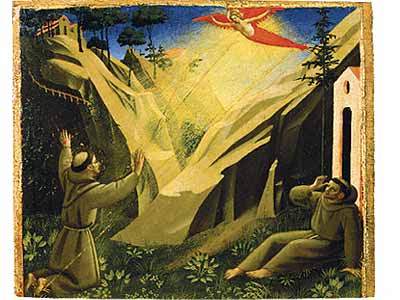
Of all the the Italian masters, Guido di Pietro (1395?–1455) is the sweetest, which is why he became known as Fra Angelico. No other light descends from heaven with such poetic radiance. No one else paints such fresh-cheeked angels, tells the old stories with more charm, or creates a light of greater purity. Angelico never seems to be showing off, despite the genius and the gold, which also contributes to his angelic effect. He’s childlike, humble, and pious, his work an offering to God, not Mammon. Most miraculous of all, given the general air of saintliness, he’s never sentimental. (Not a few painters of piety, when they depict the Lamb, make me think of lamb chops.) Angelico has a radical eye. He takes extraordinary chances with color, and his compositions are subtle, intricate and brilliantly built. A simple saint? Perhaps, but also a simply thrilling painter.
I did not think it was possible, in this country, to present an exhibition of a Renaissance master as rich and expansive as this “Fra Angelico,” which recently opened at the Metropolitan Museum of Art. Although the museum couldn’t borrow the artist’s large frescoes and altarpieces, the curators, led by Laurence B. Kanter, have still managed to collect nearly 75 smaller pictures—including several masterpieces—along with 45 works by his assistants and followers. The absence of large-scale pieces matters less with Angelico, in any case, than it would with many other painters: His monumental works are intimate, and his intimate works are often monumental. A Dominican who spent much of his life around Florence, Angelico is best known for the frescoes he painted in the dormitory cells at the Convent of San Marco in Florence, which were devotional aids. He was an important innovator in the history of art, helping to develop the laws of perspective and bring to the human figure a greater naturalism. What interests me about the show, however, is less the art history than the range and depth of the artist’s sensibility.
As sweet as he was, Angelico also understood anguish. The curators have included a shocking painting—Christ Crowned With Thorns—that will force even the art-is-a-Christmas-card crowd to acknowledge Angelico’s intensity. In this picture of a Christ whose eyes and lips have been reddened by blood dripping from the crown of thorns, Angelico probed the varied meanings of “red.” The picture contains, in addition to the clotting blood, the earthy red of a luxurious tunic, the flat, royal red of the divine (in the halo), and finally, the color of human anguish—a watery reddish-pink in which the blood of the brutalized body seeps into eyes that see too much and parted lips that cannot speak. Again and again, the artist’s formal imagination gives to whatever scene he is depicting an unexpected force. In The Stigmatization of Saint Francis, the angel’s light seems to cleave apart a mountainside, suggesting how complete was the opening of Saint Francis’s soul, and simultaneously appears to open a path to heaven. Although the other monk shielding his eyes is less open to revelation than Francis, he’s not an afterthought. The soaring verticals Angelico places at his hand and head—a tree and a doorway—suggest that timid souls, too, yearn for the sky.
The formal brilliance of Fra Angelico, together with the range of his sensibility, does more than enhance the pictorial interest and psychological complexity of his art. It also creates a powerful context for his celebrated sweetness. If an artist of such acuity chooses more often than not to apply his gifts to images of gentleness, well, then perhaps the world should pay more respect to such values. Angelico is not an artist whom you can tell to toughen up. In no other painter does the gentle seem so strong.
Fra Angelico
Metropolitan Museum of
Art.
Through January 29.